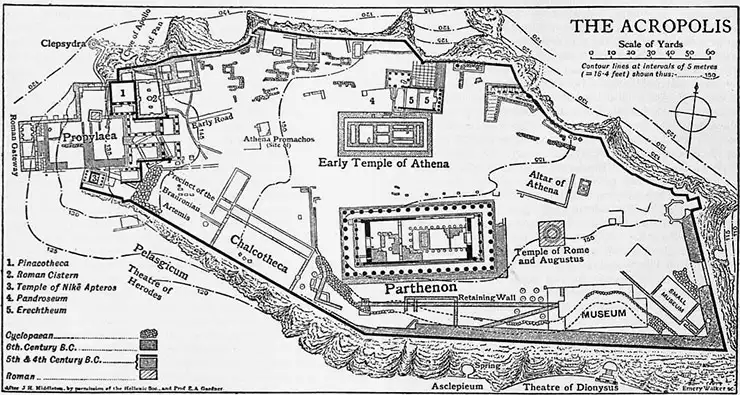History of the Athens Acropolis
The Acropolis of Athens, and the temple of the Parthenon which crowns the top is one of the most instantly recognised structures in the world. Standing proudly above the city of Athens, the Parthenon is a symbol of Ancient Greece in all it's glory and greatness.

The history surrounding the Acropolis rock and the Parthenon is one of immense interest and fact, which shaped, not only the city of Athens, but the whole of country of Greece. The rock of the Acropolis, was first inhabited in around 3000 B.C.
The name “Acropolis” means “the summit of the city”. In Ancient times, the nearby Lycabettus Hill, which is actually higher than the Acropolis rock, was actually considered to be outside the limits of the city, therefore making the Acropolis the highest point in the city at that time.
The huge summit, measuring 300 meters in length (984 ft) and 156 meters at its widest point 156 meters (512 ft), and standing at 115 meters in height, meant that the Acropolis was the perfect site for the city of Athens, as it offered unprecedented protection due to it's superior location and structure.
The Acropolis Summit Becomes the City's Main Square
It was not until the 2nd Millennium B.C. during the Mycenean Period that the summit was used as the cities main square. It is believed that a Royal Palace was based here, similar to those found at Pylos and Mycenae. The remains of the fortifications of the palace are still visible today, though nothing remains of the palace itself.
It was in this period that the Acropolis was fortified with walls. These walls were known as “Cyclopean” walls, simply because it was not believed that such technically structured fortifications could have been built by man, and, as with similar walls at Mycenae, they were attributed to the mythical Cyclops.
Athena vs. Poseidon
The founding of the city can be traced back to myths which date from the Mycenean times. It is said that King Kekropos was regarded by the people as the king of the city, after emerging from an earthquake. The city was known at this time as Kekropia, after the King. Kekropos was also to judge the competition between Athena and Poseidon as to who would have rule over the city and the general region of Attica.
Legend tells us that Poseidon struck the rock of the Acropolis with his trident, and a stream of water appeared (with which to provide water for the people of the city), with a horse leaping out from the point where his trident struck. Athena responded with striking the rock nearby with her spear, resulting in an olive tree sprouting from the ground. The olive would later become a source of wealth for Attica.
Athena Becomes Protector of Athens
It was judged that Athena had won the contest. She became the protector of the city, and in recognition of her achievement, the city was named Athina, replacing the previous name of Kekropia. After his death, Kekropos was buried at the spot where the olive tree of Athena and the stream of Poseidon had both sprung from. The building known as the Erechtheum, was built on this spot 1000 years later by Pericles.
In 800 B.C., following the demise of the Mycenae period, the Acropolis was converted into a sacred area, where a great number of Gods were worshiped. In 480 B.C. during the Persian invasion, all temples dating from the 7th and 6th Century B.C. were burnt down.
Though these temples were destroyed, some treasures from this time, such as the famous Caryatids, were found amongst debris in 1865, and are now housed in the Acropolis Museum.

The Golden Age of Athens
The Acropolis and monuments that we see today date from the 5th Century B.C. This period of time is known as the “Golden” or “Periclesian” period, and was a time of great prosperity and growth of the country. The Golden Age was not just one of political and military success, but also one of artistry and talent with the explosion of art, architecture, philosophy and drama.
Pericles (c.495 – 429 B.C.) was an important and influential figure in Athens during this period of time. Pericles oversaw a lavish and inspirational rebuilding programme to regenerate the city after the destruction caused during the Persian rule. Within just 50 years, the face of the Acropolis had been changed forever, with the construction of buildings and monuments such as the Parthenon (447 – 438 B.C.), the Temple of Nike (432 – 421 B.C.) and the Erechtheum temple (421 – 395 B.C.).
The “Delian League”, which was an alliance of several city states to counter the Persians, had a treasury that was located on the island of Delos. However, in 454 B.C., the treasury was moved to Athens, for apparent safe-keeping. Finances were actually stolen from the treasury in order to fund the works and construction of the Acropolis and it's mighty temples.
It is said that some of the financial records for the Parthenon actually survive, and the largest expense during the construction was the transport of the marble and stone from Mount Pentili, which is approximately 16km from Athens.
Plan By Encyclopædia Britannica, 1911 [Public domain], via Wikimedia Commons